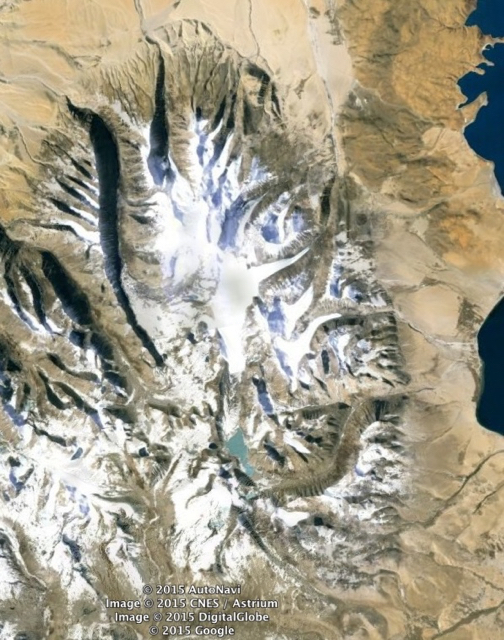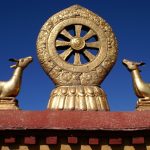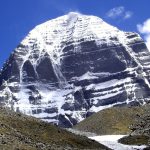FACE of SHIVA
Gurla Mandhata, Gurla Range, Tibetan Plateau
INTRODUCTION
A great icy face, over 300 square miles in size, rests on the vast summit of Gurla Mandhata, the highest peak of the Nalakankar Himal range at 24,839 feet.
Hindu pilgrims in the far away Kashmir Himalayas say they have seen their god Shiva, overlaid on a jutting ice shard across the great span of mountains. He is their Supreme Being, both Creator and Destroyer–the Many in the One.
GEOGRAPHY
The name Tibet is from the Sanskrit word Trivistapa that means “heaven.” At 16,000 feet, the Tibetan Plateau is known as the roof of the world, the highest plateau on earth and is encompassed on all sides by great mountains. National Geographic affirms that “ two billion people in more than a dozen countries — nearly a third of the world’s population — depend on rivers fed by the snow and ice of the Tibetan plateau region.”
MYTHOLOGY
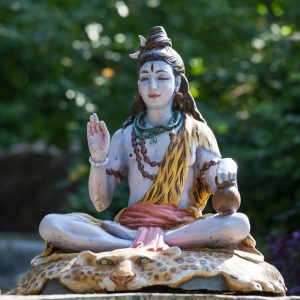 Shiva is depicted as the meditating mountain yogi with his third eye fully awakened, representative of wisdom. His right eye is the Sun and his left eye the Moon. In one classic tale Shiva saves the world by swallowing the poisons churned up by the Waters of Creation. As a result Shiva’s throat turns turquoise-blue and he is known forevermore as the Blue-throated one.
Shiva is depicted as the meditating mountain yogi with his third eye fully awakened, representative of wisdom. His right eye is the Sun and his left eye the Moon. In one classic tale Shiva saves the world by swallowing the poisons churned up by the Waters of Creation. As a result Shiva’s throat turns turquoise-blue and he is known forevermore as the Blue-throated one. 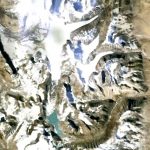 In Hindu mythology, Shiva is either sitting on a tiger skin or wearing the golden tiger around his shoulders, as in this landscape. The tiger is said to be a vehicle of Shakti–Goddess of power and force. The serpent coiled around his neck refers to the dormant “serpent” of the Kundalini, a thousand year-old yogic meditation practice developed to cultivate spiritual awakening.
In Hindu mythology, Shiva is either sitting on a tiger skin or wearing the golden tiger around his shoulders, as in this landscape. The tiger is said to be a vehicle of Shakti–Goddess of power and force. The serpent coiled around his neck refers to the dormant “serpent” of the Kundalini, a thousand year-old yogic meditation practice developed to cultivate spiritual awakening.
Tibetan Buddhists call Gurla Mandhata both the Mountain Goddess and Naimona’nyl-Holy Mother Mountain. Kailash is called Kang Rimpoche, the Spiritual One of Glacial Snow. Between these two great mountains lie two unique lakes lying side by side within this valley.1 In the Tibetan language, the more circular lake is called Mambum Yumtso or Mind Lake while the phallic-shaped lake is known as Lanang Tso or Demon Lake. On the shore between the two lakes sits a most appropriate sculpture – the Wheel of Dharma – representing the Eightfold Noble Paths; Love, Courage, Patience, Peace, Magnanimity, Goodness, Faith and Gentleness.2
Shiva’s beloved Kailash is the object of his calm gaze.3 In my own personal meditation upon this image, Shiva looks through the center pathway, beyond the Demon and Mind Lake on either side, perhaps beyond attachment to all distinctions, all opposites, all separation. In his gaze he is one with his Beloved.4
- 1
- 2
- 3
- 4
MINERALS
 Tibet is the world’s largest uranium reserve. This also makes it a target for exploitation by metal hungry countries such as China. Uranium ore (uranite) is described as very hard, heavy, radioactive and silver-colored, containing aspects of calcium, magnesium and copper. In the Navajo Lands of the American Southwest uranium was abundant. The Navajo viewed the ore as a shape-shifter metal, due to it containing all aspects of major metals. In its natural or rock state uranium was non-toxic and was actually used to help heal the immune system as well as awaken deeper aspects of ones true self.
Tibet is the world’s largest uranium reserve. This also makes it a target for exploitation by metal hungry countries such as China. Uranium ore (uranite) is described as very hard, heavy, radioactive and silver-colored, containing aspects of calcium, magnesium and copper. In the Navajo Lands of the American Southwest uranium was abundant. The Navajo viewed the ore as a shape-shifter metal, due to it containing all aspects of major metals. In its natural or rock state uranium was non-toxic and was actually used to help heal the immune system as well as awaken deeper aspects of ones true self.
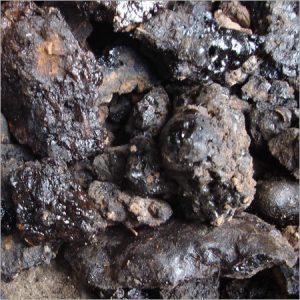 The name of Naimona’nyl at Gurla Mandhata means black medicine hidden in rocks. It is found within Gurla Mandhata’s deep black ridges. The Tibetan call it Shilajit, “rock conqueror and destroyer of weakness”. A rich mineral pitch, Shilajit contains fulvic acid that helps to strengthen the immune system; scavenge heavy metals; detoxify pollutants and help correct cell imbalances. Most importantly, it bonds with minerals and transforms them. Fulvic acid is also found in the Andes Mountains and in the bogs of Alaska, and wetlands that accumulate peat – a deposit of dead plant materials and moss.
The name of Naimona’nyl at Gurla Mandhata means black medicine hidden in rocks. It is found within Gurla Mandhata’s deep black ridges. The Tibetan call it Shilajit, “rock conqueror and destroyer of weakness”. A rich mineral pitch, Shilajit contains fulvic acid that helps to strengthen the immune system; scavenge heavy metals; detoxify pollutants and help correct cell imbalances. Most importantly, it bonds with minerals and transforms them. Fulvic acid is also found in the Andes Mountains and in the bogs of Alaska, and wetlands that accumulate peat – a deposit of dead plant materials and moss. 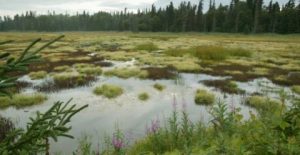 Scientists have found that it is an element that makes nutrients absorbable, giving them the ability to make a dramatic impact on all kinds of diseases and health problems that afflict us today. Shilajit, the Elixir of Life, is called the Miracle Molecule.
Scientists have found that it is an element that makes nutrients absorbable, giving them the ability to make a dramatic impact on all kinds of diseases and health problems that afflict us today. Shilajit, the Elixir of Life, is called the Miracle Molecule.
HOW TO LOCATE THE LANDSCAPE
Finding landscapes is a matter of patiently searching small areas of your map at varyingly levels of altitude. Some landscapes are only 500 feet in length while others are a phenomenal 2,000 miles in length. The larger the landscape the farther away you have to be to see it. Check places that you have always liked to go, as familiarity can help. Bear in mind that not all landscapes are found right side up!
